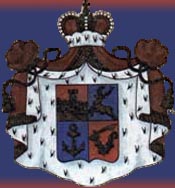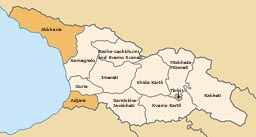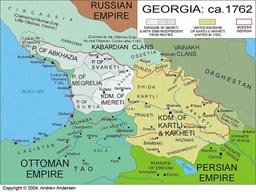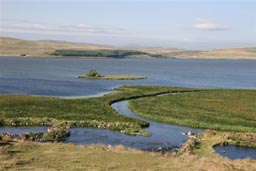
Georgia
Geography
Georgians reside in the mountainous region of South Caucasia. From the North, Georgia is bordered by Russia, from the Southeast by Azerbaijan, from the South by Armenia, from the Southwest by Turkey and from the West by the Black Sea. Georgia is the watershed between Europe and Asia. Its location helped to ensure a sense of resilience among tribes, and it also created the need to protect its settlements from Persia, Ottoman, and Russian foes as well as from internal insurgents. Today, Georgia’s land mass is about 27,000 square miles including the autonomous Republic of Abkazia. Its population is about 4.3 million. Its beautiful diverse landscape and climate variations entice and impress travelers. In ancient times, as part of the great Silk Road, it attracted merchants, missionaries, and pilgrims. Currently, it is conducting a campaign to attract investors, tourists, and Georgian émigrés who reside in Russia, France, and other countries.
History
Georgia has emerged as the birthplace of the first Europeans and is often called the "cradle of European civilization." Remains of the earliest hominids, outside of Africa, were unearthed in 1991 at Dmanisi, Georgia. Srveral skulls and a full skeleton were found; they are estimated to be about 1.8 million years old thus representing an evolutionary bridge between man’s ape like forebears and ourselves.
The next major chapter in Georgia’s history is related to a treasure trove of gold and silver objects discovered in Vani, a templar city located in Western Georgia. The items, which date from the 8th to the 1st Century BC, are linked to the prosperous settlement of Colchis which might have been colonized or might have been a trading center. They are also linked to the legendary Greek hero, Jason, and the Argonauts. Vani produced vast arrays of exquisite artifacts including potterykat, gold and silver jewelry, graceful bronze sculptures, and a vast variety of funerary pieces. The pieces are characterized by advanced metallurgical techniques and Greek and Persian influences.
During the last century of pre-Christian Georgia, the Georgian Kingdom was tied to Rome. In 330 AD, King Marian III adopted Christianity which strengthened Georgia’s ties to the Byzantine Empire. In 645 AD, neighboring Arabs captured Tbilisi. In 813, the Bagradids ruled a part of Georgia, and in the 11th Century Bagrat IV united East and West Georgia.
In 1099-1125, David IV (David the Builder) transformed the country by defeating the Turks and expanded Georgia’s territory Southward into Armenia and Eastward to the Caspian Sea. The golden age that he ushered in concluded when Queen Tamar’s reign ended in 1212. The Mongols invaded Georgia in 1236. The capture of Constantinople by the Ottomans in 1453 began three centuries of Turkish domination in Georgia.
In the late 1700s, Erekle II united the Eastern provinces of Kartli and Kakheti. He soon turned to Russia to gain protection from the unpopular Turks. In 1801, Tsar Alexander I of Russia abolished the Kingdom of Kartli and Kakhetia and Russian prescence steadily increased. after 1000 years, the Bagradid Dynasty ended its reign. In 1810, Tsar Alexander annexed the Western Kingdom of Imereti. As a result of several Russian wars against Turkey and Persia, other territories were annexed to Georgia, a part of the Russian’s strategic base in the Caucasus.
In 1918 Georgia declared independence and was under British protection from 1918-1920.In 1921, the Red Army invaded Georgia and from 1922-1936, Georgia became a part of the Transcaucasian Soviet Federated Republic. In 1936, the federated republic was split up as Armenia, Azerbaijan, and Georgia. The three countries remained separate Soviet Social Republics of the Soviet Union until the end of 1991.
In 1989, Georgian nationalism again began to resurge. In 1991, Georgia became an independent state. At present, it is the focus of conflicting interests between the U.S. and Russia. It is also facing a challenge from two separatist regions, Abkhazia and South Ossetia, which have close ties to Russia. Nonetheless, Georgia aspires to join Nthe North Atlantic Treaty Organization (NATO) and the European Union (EU).
Culture
Georgia’s capital, Tbilisi, is an intriguing mix of European, Oriental and Georgian styles. In a single neighborhood, Georgian Orthodox and Roman Catholic churches are located near a mosque and a synagogue. Ethnic Georgians form a majority of slightly over 80 percent. Other smaller ethnic groups include Russians, Armenians, Azeris, Abkhazians, Assyrians, Chuchens, Chinese, Greeks, Kurds, Jews, Tarters, Turks and Ukranians. Within certain parts of the country, non-Georgian ethnic groups speak their native languages, as well as Georgian, and maintain their rich folklore.
Georgian culture reached a high point in the late 12th and early 13th centuries in the fields of classical literature, philosophy, and architecture, most notably castle and church architecture. In the 19th Century, national literature in Georgia experienced a revival. In the 20th Century, Georgian painting, music, dance, theater, and film became well known throughout the world. Georgia's exceptional cuisine and fine wine are also well known. Visitors are fascinated by Georgia’s cuisine, a mix of Eastern and Western flavors characterize much of the dishes made with organically grown ingredients. There are more than 500 varieties of grapes, and wine is found in all colors from dark red to pale white, from exceptionally dry to extremely sweet and from mellow to new. Visitors are impressed with Tsinandali, Saperavi, and Manavi brands which are sold locally and exported.
Georgia also is famous for the Georgian Table or Supra, an often extravagant dinner with many delicious dishes and toasts. The feast is conducted by a "Tamada" or toast master who conducts a series of philosophical toasts to his nation, ancestors, women and children, friendship, peace, and honored guests.
Nature
Although Georgia’s predominant feature is its mountains, Georgia has many national parks. Lagodekhi, located in the Eastern part of the country, has numerous unique plants. Vashlovani, in the South Eastern corner, is the home of the endangered Antolean leopard and several other rare species. The Kolkhetian National Park consists of three separate wetlands; it is an extraordinary bird watching location. Borjomi-Kharagauli dates back to the Tsarist period; it is on the border of the richly forested Lesser Caucasus. Tusheti is situated in the North East corner of Georgia; it borders Dagestan and Chechnya. It is sealed off by high snowy passes eight months out of the year but for four months it is replete with grass plateaus and picturesque villages guarded by towers.
Concluding Observations
Georgia’s story is tied to numerous intrusions from the North, South, East and West as a result of invasions and trading patterns. Georgia is comprised of many distinct ethnic groups and it always seems to be, to a greater or lesser degree, in flux. And while there is uncertainty about whether the nation will maintain its sovereignty, Georgia’s efforts to preserve its own identity and engage in mutually supportive relationships with other nations continues to thrust it deeper into Western Europe and away from Russia. Military and commercial investments by the United States and oil rich Arab nations underscore its breach with Russia.
Source bibliography:
- Antelava, Ilia. Dumbadze, Mamia. Ed., Saqartvelos istoriis narkvevebi [Essays of Georgian history]. Vol IV. Tbilisi: Sabchota Saqartvelo, 1974.
- Guruli, Vakhtang. Sakhartvelos istoria, XX saukune [Georgian history: XX Century]. Tbilisi: Tbilisis saxelmcipho univesritetis gamomcemloba, 2003.
- Khaukhchishvili, Simon, ed., Qartlis Tskhovreba; Vakhushti Batonishvili: Agtsera samephosa Saqartvelosa: [Life of Khartli; Vakhushti Batonishvili’s Describing Kingdom of Georgia] vol. IV. Tbilisi: Sabchota Saqartvelo, 1973.
[ TOP ]



